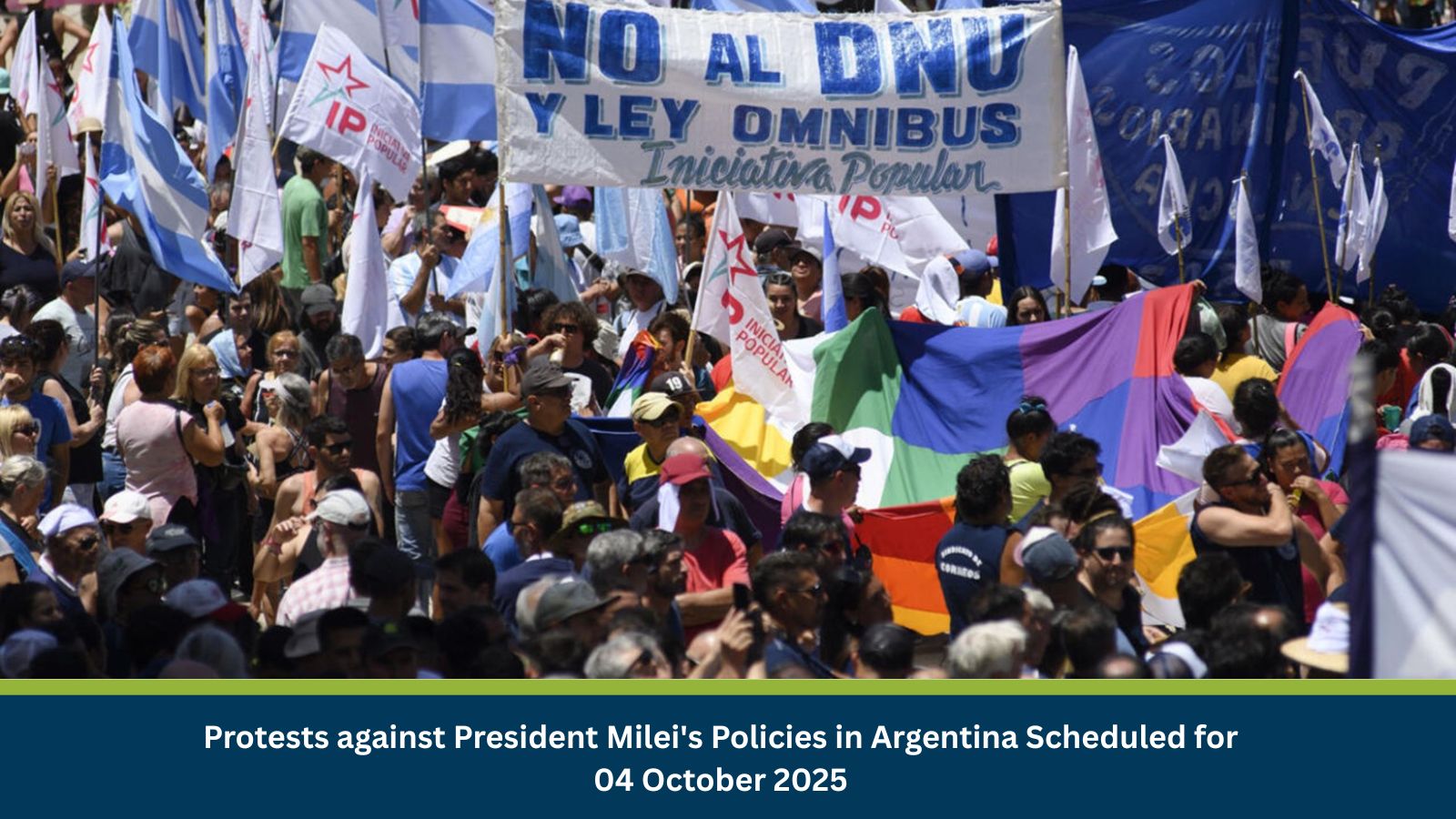What is Risk Analysis in the Context of Civil Disturbance Events
Civil disturbance risk analysis examines how organized protests, strikes, and social unrest affect safety, infrastructure, mobility, and business operations. In Argentina, mass mobilizations—especially by agricultural and transport unions—have historically disrupted national logistics and economic activity. This assessment helps stakeholders anticipate disruptions, assess escalation scenarios, and plan operational resilience amid heightened political tensions.
Executive Summary
- Date of Incident: 04 October 2025
- Location: Buenos Aires, San Andrés de Giles, Argentina
- Risk Category: Civil Disturbance
- Severity Score: 4/5
- Confidence Level: 80%
A major wave of farmer-led protests, branded as “tractorazos,” is planned for 04 October to oppose President Javier Milei’s economic policies. The demonstrations are expected to block highways and rural transit corridors across key agricultural provinces. Drawing parallels with Argentina’s historical general strikes and mass mobilizations, the protests will likely cause 24–72 hours of significant disruption, with spillover effects in logistics and trade. Escalation risks remain moderate to high due to the political polarization surrounding the reforms.
Current Updates
Farmers and agricultural producers are mobilizing nationwide under the banner of “tractorazos” to oppose policies they claim undermine rural livelihoods. Demonstrations are expected to involve slow-moving convoys and road blockades using heavy machinery. The protests echo earlier large-scale rural mobilizations, with slogans like “Somos productores, no esclavos del saqueo” (“We are producers, not slaves of looting”). These actions signal renewed tensions between the agricultural sector and the central government amid ongoing inflation, subsidy cuts, and policy disputes.
Known Hotspots and Sensitive Areas
High-risk areas include Buenos Aires Province (notably San Andrés de Giles, Junín, and Rosario corridors), major export hubs such as Bahía Blanca and Rosario Port, and national highways RN 7, RN 9, and RN 3. Central government buildings like Casa Rosada, the Ministry of Agriculture, and provincial offices could serve as symbolic targets for demonstrations.
Impact on Transportation and Services
Expect widespread highway blockades disrupting freight and inter-city travel. Logistics routes for agricultural produce, consumer goods, and fuel are vulnerable. Inter-city bus operations and cargo movement toward ports and industrial zones will be delayed. Urban congestion is probable near protest entry points into Buenos Aires. Air and rail travel disruptions remain minimal unless routes to airports or rail terminals are obstructed.
Recommended Actions
- Operational Continuity: Implement remote work or flexible scheduling for staff in high-risk regions.
- Security Measures: Secure physical assets, reinforce site perimeters, and limit exposure of vehicles near protest-prone highways.
- Supply Chain Diversification: Engage logistics providers to plan alternate routes, backup warehousing, and adjusted shipment schedules.
- Crisis Response: Activate cross-functional crisis cells (HR, Operations, Security, IT) and ensure 24/7 monitoring of protest trajectories.
- Communication Protocol: Issue pre-emptive client and stakeholder advisories outlining possible delays and mitigation steps.
- Information Channels: Monitor verified government and law enforcement channels for real-time updates (Ministerio de Seguridad, Casa Rosada).
Multidimensional Impact
The “tractorazos” could generate collateral effects across multiple dimensions. Supply chain disruptions may delay agricultural exports, dampening Argentina’s fragile economic recovery. Prolonged road blockades might affect access to urban centers, healthcare facilities, and ports, amplifying social frustration and triggering solidarity protests from transport and labor unions. Politically, the unrest risks undermining investor confidence and further polarizing rural–urban relations. Indirectly, media coverage of stalled logistics and stranded goods could exacerbate public discontent, reinforcing narratives of state inefficiency and weakening government credibility at a crucial policy juncture.
Emergency Contacts
- Police: 101
- Fire Department: 100
- Ambulance: 107
- National Emergency: 911
- Official Channels: Casa Rosada, Ministerio de Seguridad, Javier Milei (X handles)
- Key Portals:
- Presidency of Argentina – www.casarosada.gob.ar
- Ministry of Security – +54 11 5275 5000
- Ministry of Economy – +54 11 4349 5000
Final Thoughts
The forthcoming “tractorazo” protests underscore the enduring volatility of Argentina’s socio-economic landscape, where fiscal reform and social discontent often intersect. While immediate impacts will center on transport and logistics paralysis, the deeper concern lies in the widening divide between rural producers and the central government. If handled through dialogue and measured restraint, disruptions may subside within days. However, a coercive or dismissive government response could intensify the unrest, drawing in unions and urban protest movements, with ripple effects on governance stability and market sentiment.
For businesses, this event highlights the strategic value of preparedness, maintaining operational flexibility, robust communication networks, and real-time intelligence. Beyond physical risk management, organizations must also plan for reputational and continuity challenges in an environment where political dissent and economic uncertainty remain cyclical. In essence, resilience in Argentina today depends less on avoiding disruption and more on adapting to it swiftly and intelligently. Stay ahead of operational risks with real-time alerts, scenario modeling, and expert advisories with datasurfr’s Predict. Start your 14-day free trial of Datasurfr’s Risk Intelligence Platform today.






